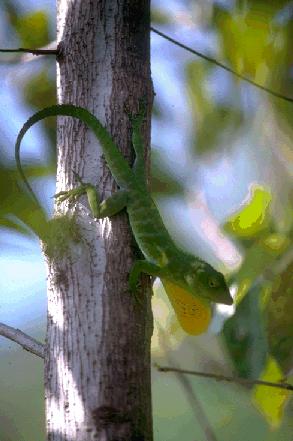





 This
is a Cuban Anole.
This
is a Cuban Anole.

General Information:
The Green Anole is a native of the southeastern USA. It is a slim, 6-8" (15-20 cm.) long, highly active lizard, seen around homes on walls and trees. Its color can change from green to brown depending on the temperature, its surroundings and its health. Males display a reddish throat dewlap nearby females and in threat displays to other males. Anoles are highly social and do best in a group situation with a ratio of 1 male to 3 females.

The Green anole (Anolis carolinensis), is the most seen species in pet shops.
Diet:
Anoles
need not only live food but also small amounts of fruit. Crickets, spiders,
tiny earthworms,flies, tiny bits of ripe banana, oranges, and spinach are
acceptable.
Where
do Green Anoles come from?
Southeastern
USA and the Caribbean.
What
is their typical wild habitat?
Everywhere
– bushes, trees, rock walls, woods and around houses.
Are
they primarily arboreal or terrestrial?
Green
Anoles tend to inhabit low bushes rather than trees or scurry about on
the ground underneath.
What
is their preferred diet in the wild?
Diet
consists of insects, grubs, crickets, cockroaches, spiders, moths and any
arthropod which will
fit
in their mouths. They avoid sow bugs and most types of beetles.
Are
they typically diurnal, nocturnal or crepuscular?
Diurnal.
How
big do they get?
Usually
somewhere around seven inches, including tail. Wild specimens of up to
ten to twelve inches
have
been reported. Nine inches is considered big when in captivity.
What
is the life expectancy of the Green Anole?
Life
expectancy is around four years in captivity and unknown when in the wild.
What
are the differences between males and females?
Males
are larger than females and have a dewlap (throat fan) which they use to
display to females
and
rivals.
As
well as the dewlap, males may have a dorsal crest beginning just behind
the head, which is raised
as
part of the threat display. This is typically accompanied with by a partial
extension of the throat
prior
to a display of the actual dewlap.
Females may have a white stripe down the back.
It
has been observed that females may also have dewlaps. If they do, the dewlaps
are smaller than
those
of the male and displayed less frequently.
How
aggressive are they to their own species and to other species?
Green
Anoles are usually not very aggressive, but males may get aggressive if
housed together.
They
will produce aggressive displays to their reflections in mirrors. I have
not observed the same
behavior
with Bahamian Anoles.
Do
they make any noise?
No.
Do
they hibernate?
There
are mixed opinions: some say yes, some say no. It has been suggested that
they may move
into
sheltered surroundings (e.g., attics) during winter.
What other types of Anole are there?
Bahamin Anoles;
Knight (or Cuban) Anoles;
Large–headed Anoles (larger, blue dewlaps); and
many others.
What should the temperature in the enviroment be (day and night)?
Day: mid to high 80s, with a heat spot lamp.
Night: high 60s or low 70s.
What
level of humidity do they like – low, medium or high?
Medium
to high humidity is recommended but not rain forest conditions. A humidity
level of about
70%
is sufficient.
 |